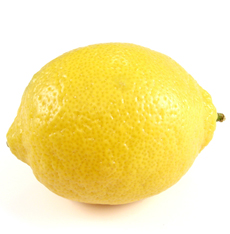
March 2010
Last Updated April 2010
|
 |
Lemon Glossary ~ Lemon Varieties
Page 1: Lemon History
CAPSULE REPORT: Whether served as a garnish on fish or meat or with tea, squeezed for its juice and zested for recipes or used in confectionary—candied lemon peel and hard candies, for example—lemon is ubiquitous in our cuisine, and many world cuisines. One can’t imagine life without lemons. This is Page 1 of a five-page article about the types of lemons. Click on the black links below to visit other pages.
The Origin Of Lemon
The origin of the lemon has not yet been determined, although science suggests it may be northwestern India, where they have been cultivated for more than 2,500 years. Arab traders brought the lemons to the Middle East and Africa sometime after 100 C.E. It is believed to have been introduced into southern Italy around 200 C.E.; and was being cultivated in Egypt and in Sumer, the southern portion of Mesopotamia a few centuries later.
At first, lemons were not widely cultivated as food: It was largely an ornamental plant (as were tomatoes), until about the 10th century. The Arabs introduced the lemon into Spain in the 11th century, and by 1150, the lemon was widely cultivated in the Mediterranean. Crusaders returning from Palestine brought it to the rest of Europe.
The lemon came into full culinary use in Europe in the 15th century; the first major cultivation in Europe began in Genoa. Lemons came to the New World in 1493, when Christopher Columbus brought lemon seeds to Hispaniola. Spanish conquest spread the lemon throughout the New World, where it was still used mainly used as an ornamental plant, and for medicine. Lemons were grown in California by 1751; and in the 1800s in Florida, they began to be used in cooking and flavoring.
The name “lemon” first appeared around 1350–1400, from the Middle English word limon. Limon is an Old French word, indicating that the lemon entered England via France. The Old French derives from the Italian limone, which dates back to the Arabic laymun or limun, from the Persian word limun.
Lemons In America
Commercial cultivation of lemons blossomed in both California and Florida in the 1800s, but due to a killer freeze in the winter of 1894-1895, commercial lemon culture in Florida ceased. Planting resumed in 1953 due to a need not for fresh lemons (of which there were plenty from California), but a market for frozen lemon concentrate, which had become popular (along with frozen orange concentrate), and for natural cold-press lemon oil.
Of the 200 or so cultivars (distinct varieties) of lemon that can be found in the U.S., some are best for lemon oil, some for juice and some are the best all-around. Some cultivars are more vigorous (disease-resistant), some are more productive (they bear more fruit), some have fewer seeds, some are better in humid climates like Florida, in arid climates like Arizona and Texas or in colder climates.
Lemons are hand-picked (they can’t be machine-harvested, or picked wet). They’re then sorted according to color, washed, coated with a fungicide to prevent stem-end rot, coated with a thin layer of wax for preservation and attractiveness and cured (stored) until ready for shipping.
|
|

The Lisbon lemon (above) and the Eureka
lemon are the two most prevalent in the U.S. Photo courtesy Pachd.com.
|
During curing, which can take days (or can happen in transit, as the lemons take days to be shipped to their destination), the peel of the picked fruit, which is green, turns yellow. It also grows thinner and the pulp gets juicier.
Now, it’s time to meet the lemons.
Continue To Page 2: Lemon Types A To F
Go To The Article Index Above
Some information courtesy Purdue University. Copyright 2005-
Lifestyle Direct, Inc. All rights reserved. Images are the copyright of their respective owners.
|





